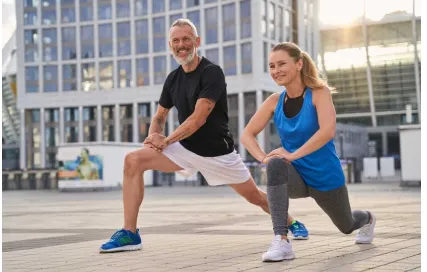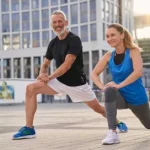Patients walk into our clinic weekly saying they never realized how much their hips controlled everything else. You know that stiff sensation when climbing out of bed? The tightness settling in after sitting through long meetings? That persistent ache that just won’t go away? You’re not alone here. Hip and groin tightness affects runners, desk workers, weekend gym-goers, and people chasing after their grandkids.
Your hips are headquarters for movement. Walking, standing, even shifting your weight while doing any work – your hips control all of it. Once they stop working properly, your body finds workarounds. Your lower back takes on extra work. Knees start compensating. Before you know it, random body parts start hurting. Catching hip problems early stops this chain reaction.
Also read: Preparing for an Unexpected Relocation: Selling Your Home Quickly
We’ve watched thousands of people stretch over the years. Most get it wrong. Too aggressive, holding poses that make things worse, or skipping the basics. Real stretching isn’t about impressive flexibility. It’s meeting yourself where you are and gently pushing boundaries a bit further.
What’s Behind the Pain
Quick question: how long were you sitting yesterday? Most people we see hit six hours or more. Those seated hours shorten your hip flexors while weakening your glutes, throwing everything off balance. Poor posture adds fuel to the fire, leaving you with tight hips that hurt every time you move.
Athletes face their own challenges. Repetitive movements, skipped recovery days, ignoring what your body’s trying to tell you. We work with lots of runners, and hip complaints come up constantly.
Now, one thing needs to be clear. If you’ve got sharp pains shooting down your leg, swelling that sticks around, or pain that keeps getting worse, don’t try fixing it with stretches alone. Get a proper evaluation because something bigger might be going on.
How Stretching Really Works
Can stretching relieve hip and groin tension? Absolutely. Here’s why it actually works.
Your muscles maintain a baseline tension level. Sitting too much or overusing certain movements ramps that tension way up, restricting your movement. Regular, gentle stretching teaches your nervous system it’s safe to relax and lengthen those tight areas.
For people stuck at desks all day, this can be life-changing. Athletes see their performance improve and deal with fewer injuries. Older patients find that flexible hips help them stay active and independent longer.
Before You Start
Just dropping to the floor and pulling on your legs sets you up for injury.
- Warm up your muscles first. Walk around your house for five minutes. Do some gentle leg swings. Get blood flowing before you stretch. Cold muscles are stubborn and injury-prone.
- Breathing matters more than you’d think. Holding your breath tells your body something’s wrong, making it tighten up protectively. Breathe slowly and deeply throughout each stretch.
Listen to what your body tells you. There’s a big difference between a good stretch and actual pain. If something hurts sharply, stop immediately.
Stretches That Actually Help
Butterfly Stretch: Sit on the floor, bring your feet together sole-to-sole, and let your knees drop outward. Hold your feet and use your elbows to gently press your knees toward the floor. Steady pressure, no bouncing. Hold 30 to 60 seconds. Great for inner thighs and groin.
Seated Figure-Four: Perfect for desk workers. Sit in a chair, cross one ankle over your opposite thigh to make a number four shape, then lean forward from your hips keeping your back straight. You’ll feel this in your outer hip and glute. Hold 30 to 45 seconds, then switch sides.
Kneeling Hip Flexor Stretch: Kneel on one knee with a pillow for comfort. Plant your other foot flat in front. Gently push your hips forward while keeping your back straight. This targets those tight hip flexors from all that sitting. Hold 30 to 40 seconds each side.
Side Lunge Stretch: Stand with feet wide apart. Shift your weight to one side, bending that knee while the other leg stays straight. You’ll feel this along your inner thigh. Hold 20 to 30 seconds, then switch.
Lying Knee to Chest: Our gentlest stretch that helps your lower back and hips. Lie on your back, bring one knee toward your chest, and hold it with both hands. Breathe deeply and hold 30 seconds per leg.
Doing these daily for five minutes beats doing an hour once a week. Consistency wins over intensity.
Warning Signs
Know these red flags. Sharp pain, tingling, or numbness aren’t normal. Stop if you feel any of these.
Professional guidance becomes really valuable here. When patients visit Total Performance Physical Therapy, we watch how they move and immediately spot issues. Sometimes it’s just adjusting foot position or changing the angle slightly. If you’re dealing with ongoing hip discomfort, working with therapists who understand movement makes a huge difference.
Why Professional Help Matters
We appreciate when people try helping themselves. But learning how to increase hip mobility safely often needs more than watching videos and hoping for the best. We look at your specific situation. Where are you tight? Where are you weak? What movement patterns cause your problems?
At our Horsham location, we’ve built programs specifically for hip mobility. People struggling with movement restrictions find real solutions here. Whether you’re dealing with sports injuries, chronic stiffness, or groin pain, we focus on finding the real cause instead of just masking symptoms.
Our approach is personalized because each person’s body is different. We serve communities throughout Montgomery County, and local support means you’re not guessing if you’re doing things right.
Daily Hip Care
Stand up every hour. Walk to the bathroom, grab water, just move. Your hips weren’t designed for staying folded 10 hours straight. Pay attention to how you sit. Uncross your legs. Keep feet flat on the floor. Drink enough water because dehydrated muscles don’t stretch well.
Small habits really do add up.
Moving Forward
Your hips are with you for life. Treating them right now affects how you’ll feel years down the road. Whether you need hip mobility physical therapy in Horsham or you’re trying to figure out recurring groin issues, consistent proper movement usually solves the problem. Knowing how to increase hip mobility safely separates progress from frustration. Can stretching relieve hip and groin tension by itself? Often it can, but recognizing when you need professional guidance matters too. Getting help doesn’t have to feel overwhelming.
Start gentle. Stay consistent. Not sure what you’re doing? Reach out to professionals for proper guidance. Your future self will appreciate you taking action now instead of waiting until pain becomes unbearable.







